

The CANUCKDUCK Experiment focuses on the sediment dynamics component of SANDYDUCK. The complete SANDYDUCK Experiment is described in the SANDYDUCK Website (http://www.frf.usace.army.mil/SandyDuck/SandyDuck.html). As shown in Figure 1, the sediment dynamics instrument locations are concentrated at the north end of the array, away from the wakes of the other instruments during periods of strong southward-flowing longshore currents generated during Nor'easters.

Drs. Bryan and Wilson maintain an association with the Canadian SANDYDUCK effort.
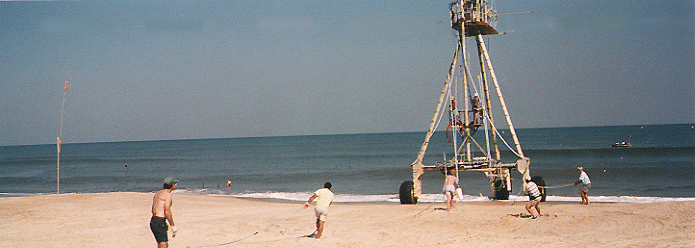
The central focus of the Canadian effort is to investigate the kinematics and dynamics of mobile sandy sediments in the natural surf zone.
The global objectives of this project are:
Specific objectives are:
The array proposed for the Canadian contribution to SANDYDUCK is in the shape of an L, with both cross-shore and long-shore segments (Figure 1). There will be 6 nodes, with 1 heavily-instrumented central node and 5 less heavily instrumented satellite nodes. The cross-shore and longshore segments will consist of 4 and 3 nodes, respectively, with 20-60m spacing between adjacent nodes. The central node is shared with both segments. The central node will include the coherent Doppler profiler. All nodes will have rotary sonars for both bedform pattern and bed relief measurements within an area 10m in diameter (10 x 15m at the central node), plus pressure and flowmeter (PUV) sensors. The hydrophones and upward-looking sonars will be mounted on the inner 3 cross-shore nodes. Two-axis tilt sensors, needed to correct the bottom images for frame attitude, will be mounted on all frames. This will be the first time that such a comprehensive measurement array will have been deployed to study sediment dynamics in the nearshore zone.
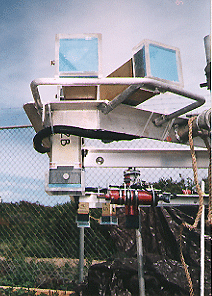
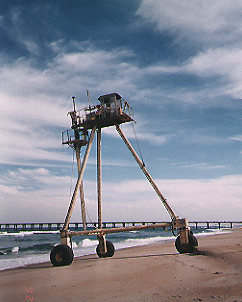
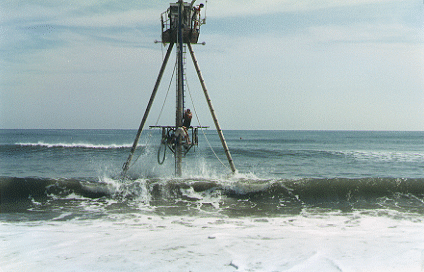
We will deploy a video camera on a 7m tower on top of the dune to image breaking waves and surface foam over the part of the array that is in the nearshore trough. In addition, Dr. Lippmann's video cameras will be mounted on a 44m-high tower on shore. The field of view of the cameras will include the complete array. Video luminance data, with m-scale resolution, will be acquired along cross-shore lines parallel to the cross-shore leg of the array, and will be used to characterize breaking events and the shoreward propagation of breakers.

The seaward end of the cross-shore segment is shared with our co-participants from the USGS, who will be deploying a vertical stack of high resolution 3-component flowmeters seaward of the bar crest, to investigate the vertical structure of the flow (i.e. the undertow profile) and the vertical momentum flux and bottom drag. The USGS has purchased a rotary sonar system similar to ours, and we are collaborating on the use of this system to characterize the bedform field and bottom roughness at the location of the current meter stack. The effects of wave breaking on the vertical structure of mean and low-frequency cross-shore flows will be studied in collaboration with Dr. Lippman. The effects of suspended sediment stratification on vertical structure will be studied in collaboration with Dr. Dan Hanes (University of Florida). Our USGS colleagues will also be deploying instruments farther offshore, extending the cross-shore segment of the array into deeper water to link up with instruments being deployed by Dr. Peter Howd (University of South Florida). This will allow us to monitor wave forcing gradients across and beyond the surf zone, making maximum use of combined resources. Dr. Howd and doctoral student Rebecca Beavers will also be carrying out a box-coring program to study the residual sediment fabric signatures of bedform development during storms, for comparison with our rotary sonar results.
The field experiment will begin in early August 1997, with the deployment of 3 of the 4 cross-shore nodes, each with rotary fan- and pencil-beam sonars and a PUV. The other nodes and sensors will be deployed in September, for the intensive fall experiment.
In the area of modelling, doctoral student Douglas Wilson successfully defended his thesis, in which a new model of bedform pattern development based on self-organization theory is developed and shown to be in good agreement with the observations (e.g. Clifton, 1976; Hay and Wilson, 1994). A paper describing this model has been submitted (Wilson and Hay, 1996). Doctoral candidate Steve Henderson is continuing with the development of this class of model for his thesis project.
Doctoral student Karin Bryan successfully defended her thesis, in which a new model explaining the observed amplification of edge wave velocities over the crest of nearshore bars is presented, and which suggests this amplification is a new potential mechanism for bar growth due to the associated drift velocities at the bed. This work is described in a series of papers, the first of which has already appeared (Bryan and Bowen, 1996). M.Sc. student Christine Pequignet is pursuing a related topic: the stochastic modelling of forced edge waves.
Postdoctoral fellow Dr. Diane Foster joined the group last summer, and is pursuing her model investigation of sediment suspension in the wave bottom boundary layer, and in particular the question of the possible role of shear instabilities in the production of suspension intermittency and nearbed turbulence. Doctoral candidate Phil MacAulay is pursuing a related topic for his project, which is the development of models of the combined boundary layer for the sea-swell band and infragravity motions, and in particular the mechanisms responsible for the observed association between wave groups and sediment supension events (MacAulay and Bowen, 1995). A poster on this topic was one of a group of talks and posters presented at the Fall Meeting of the American Geophysical Union.
The bedform measurements from DUCK94 are being used to test bedload transport models. A first paper on this topic has been submitted (Hay and Bowen, 1997), in which it is shown that wave-current boundary layer models and bedload transport models, can be combined in a way which explains the observed alongshore migration rates of avalanche-face bedforms. This is a result of considerable practical importance, as it leads to direct comparison with engineering formulae for bedload transport. The approach is being pursued in theoretical and computer simulation studies of the roles of the direction and frequency distributions and non-linearity of the incident wave field. Doctoral candidate Amani Ngusaru is working on a closely-related but more difficult problem, which is the cross-shore migration of these large bedforms. Doctoral student Anna Crawford is also investigating bedload transport models in the context of bedform migration, but is focussing on smaller-scale features.
Doctoral student Ian Clark is using results from a recent field experiment in which bubble cloud measurements were made, and is using these results to compare to theoretical models of the vertical structure of cross-shore flow.
Sara Bass' M.Sc. thesis paper, on surf zone ambient noise and wave breaking frequencies, is in press, as an Invited Paper in the IEEE Journal of Oceanic Engineering (Bass and Hay, 1996).
Doctoral candidate Anna Crawford has submitted a paper describing her laser-video system for 2- and 3-dimensional measurements of bed profiles and sediment suspension clouds.
Doctoral candidate Carolyn Smyth has carried out experiments with our new coherent Doppler profiler (Zedel et al., 1996), and a hot-film turbulence probe. Her results demonstrate that the Doppler remotely measures the inertial subrange of the turbulent kinetic energy spectrum. She is using results from recent field experiments, and the results to come from SANDYDUCK, to investigate nearbed turbulence levels in relation to sediment suspension.
Dr. Len Zedel has been investigating the remote measurement of sediment flux by using the Doppler profiler in controlled laboratory environments: both the particle-laden turbulent jet (Hay, 1991), and the Wave Research Flume at the National Research Council (Ottawa). These results are being written up, both for the jet experiments (Zedel and Hay, 1997) and the wave experiments (manuscript in preparation).
Engineer David Hazen, together with technologists Walter Judge and Wes Paul, have been designing and assembling the hardware for the data acquisition and control network. A block diagram of the system is presented in Figure 2. The system is based on, but also a considerable advance beyond, systems described by Craig et al. (1995) and Hazen and Bowen (1996). As indicated in the Figure, the system comprises 8 data acquisition PC's plus 3 PC's for initial processing and hard-copy documentation of the incoming raw data, all in a 40-ft data acquisition trailer, plus 6 underwater data acquisition nodes, each plugged into an ARCnet hub. In addition, 2 UNIX workstations plus 2 X-Terminals will be set up for mass processing. Most of the critical components of this system are in place and operational. Assembly and testing of the remaining components will take place during the next eight weeks. The equipment is scheduled to leave Dalhousie for Duck on July 11.
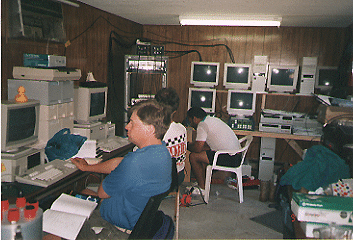
Collaborative links between the Canadian investigators and other SANDYDUCK PI's are with:
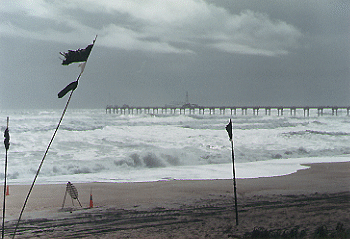
Bowen, A.J., 1997. Patterns in the Water, Patterns in the Sand? Coastal Dynamics '97, Plymouth, U.K., June (keynote address).
Foster, D.L., 1997. Time-Dependent Stability of the Wave Bottom Boundary Layer. Costal Dynamics '97, Plymouth, U.K., June.
Foster, D.L., A.J. Bowen, R.A. Beach, and R.A. Holman, 1996. A Comparison of Field Observations and Quasi-Steady Linear Shear Instabilities of the Wave Bottom Boundary Layer. 25th Coastal Engineering Conference, Sept. 1996.
Foster, D.L., and A.J. Bowen, 1996. Wave Bottom Boundary Layer Shear Instabilities. AGU Fall Meeting, Dec. 15-19.
Hay, A., 1997, Shape shifting in nearshore sands: linking bedform evolution to nearshore circulation, Invited, Gordon Research Conference on Coastal Ocean Circulation, 15-20 June, New London, NH
Hay, A.E., and A.J. Bowen, 1996. On Longshore Migration of Lunate Megaripples During Duck94. AGU Fall Meeting, Dec. 15-19.
Hay, A.E. and L. Zedel, 1996. Sediment Concentration and Velocity Structure of Suspension Clouds During Wave Groups. AGU/ASLO Ocean Sciences Meeting, Feb. 12-16.
MacAulay, P., A.E. Hay, and A.J. Bowen, 1996. Sediment Plumes: A Shear Instability of the Infra-gravity Velocity Profile. AGU Fall Meeting, Dec. 15-19.
Zedel, L. and A.E. Hay, 1996. Nearshore Observations of Vertical Momentum and Sediment Flux Using Coherent Doppler Sonar. AGU/ASLO Ocean Sciences Meeting, Feb. 12-16.
Bryan, K.R., P.A. Howd, and A.J. Bowen, 1997. Field observations of bar-trapped edge waves. J. Geophys. Res. (in press).
Foster, D.L., A.J. Bowen, R.A. Beach and R.A. Holman, 1997. Linear instabilities of the wave bottom boundary layer; theory and observations, J. Geophys. Res., (in prep.)
Hay, A. E. and A. J. Bowen, 1997. Alongshore migration of lunate megaripples during DUCK94: Part I. J. Geophys. Res. (submitted)
Lippmann, T.C., R.A. Holman and A.J. Bowen, 1997. Generation of edge waves in shallow water. J. Geophys. Res., 102, 8663-8679.
Bass, S. J. and A. E. Hay. 1996. Ambient Noise in the Natural Surf Zone: Wave Breaking Frequency. IEEE J. Oceanic Eng. (invited).
Bryan, K.R. and A.J. Bowen, 1996. Edge wave trapping and amplification on barred beaches. J. Geophys. Res. 101, 6543-6552.
Foster, D.L., A.J. Bowen, R.A. Beach and R.A. Holman, 1996. A Comparison of Field Observations and Quasi-Steady Linear Shear Instabilities of the Wave Bottom Boundary Layer. Proc. Int. Conf. of Coastal Engr., ASCE, in press.
Hazen, D.G. and A.J. Bowen, 1996. UDATS-II Data acquisition in a client-server environment. IEEE J. of Oceanic Engr. 21, 305-312.
Schaafsma, A. S. and A. E. Hay. 1996. Attenuation in Suspensions of Irregularly-Shaped Sediment Particles: A 2-Parameter Equivalent Spherical Scatterer Model. J. Acoust. Soc. Am. (accepted).
Zedel, L., A.E. Hay, R. Cabrera, and A. Lohrmann, 1996. Performance of a Single Beam, Pulse-to-Pulse Coherent Doppler Profiler. IEEE J. Oceanic Eng. 21(3), 290-297.